Experimental Study of See-Saw Mode Nano-Vibration on Orifice-Type Restrictors
Abstract
:1. Introduction
2. Materials and Methods
2.1. Orifice-Type Flat Restrictor Vibration Model
2.2. Simulation on One-Orifice-Type Restrictor Based on FEM FSI
- The greater the inlet air velocity, the greater the restrictor vibration, as shown in Figure 4. Interestingly, the peak–valley values of the time-averaged amplitudes on the circumference are identical (0.003 nm) under different air-supply pressures, meaning that even if the speed of the inlet air changes (representing the air-supply pressure and the gas film distribution change), the restrictor maintains the same rotational amplitude. If the vibration signal is expressed with direct-current (DC) and alternating-current (AC) components, the inlet air velocity only changes the DC component.
3. Experiments and Results
3.1. Experimental Setup
3.2. Time-Domain Results of Restrictors’ Vibration
3.3. Frequency-Domain Results of Restrictor Vibration
4. Discussion
- Normal nano-vibrations are generated at different measurement positions of the restrictor under different air-supply pressures with amplitudes ranging in picometer or nanometer order. For each position, the amplitudes of the normal nano-vibrations increase equally with the increase in air-supply pressure. This reveals the existence of normal vibration, and its magnitude is related to the air pressure. The greater the air pressure, the greater the vibration.
- For the double-ring-grooved style restrictor under the same air-supply pressure, the measured positions of P1, P2, P3 and P4 had the largest similar vibration amplitudes. Those of positions P5 and P6 were reduced and close, and that at position P7 was the smallest. This shows that the normal vibration is a form of rotational vibration, which is consistent with the theoretical analysis (Section 2.2). This vibration form represents the see-saw mode discussed. For the one-orifice double-ring-grooved style restrictor, its vibration rotation axis should be in the restrictor’s center at the orifice. More specifically, it should be located between the orifice and the center of gravity.
- For the double-U-grooved style restrictor with two orifices, the measurement data show that the vibration rotation axis is not at the center of the restrictor. It can be imagined that from a microscopic perspective, the two restrictors have the same nonidentical effect on the vibration as the spring model. Thus, the axis of rotation appears between restrictor orifice 1 and the center of gravity or between restrictor hole 2 and the center of gravity at different times. Therefore, position P7 near the center has a very large vibrational amplitude.
- The variety of air-supply pressures changes the corresponding maximum vibration amplitude among P1, P2, P3 and P4. Hence, we speculate that the different air-supply pressures change the air-film thickness, flow rate and pressure distribution, which cause slight changes in the rotation axis, including the position and angle. However, we must consider that this difference could be caused by the inaccuracy of the laser-spot positioning.
- Although the overall size was the same, the vibration of the double-U-grooved-style restrictor was larger than that of the double-ring-grooved-style restrictor. If the influence of the equalizing groove were to be ignored, then it is most likely that the two orifices would magnify the vibration far greater than one orifice would.
- The simulation results of Section 2.2 showed that even if the speed of the inlet air changes per air-supply pressure and gas film distribution, the restrictor maintains the same rotation amplitude. However, we did not observe this phenomenon. The rotation amplitude varied evidently with different inlet air pressures. This requires further exploration in a future study.
- From the results in Figure 10, it is clear that for the double-ring-grooved-style restrictor, the normal nano-vibration generated at positions P1–P7 at 0.5 MPa carried large power near 9.4 and 10.6 kHz, even though P7 had no evident power concentration. Furthermore, different measurement locations carried certain amounts of power around 21.2 and 23.1 kHz. Because 21.2 and 23.1 kHz are approximately twice the frequencies of 9.4 and 10.6 kHz, respectively, it can be assumed that 9.4 and 10.6 kHz are the fundamental frequencies of the normal nano-vibration of the restrictor, and 21.2 and 23.1 kHz are their harmonics frequencies.
- For the double-U-grooved-style restrictor, the normal nano-vibration generated at different positions at 0.5 MPa air-source pressures carried large power around 7.9, 17.7 and 25.3 kHz. However, there was no evident power concentration phenomenon at P7. Because 17.7 and 25.3 kHz are approximately twice and three times the relationships with 7.9 kHz, 7.9 kHz can be considered the fundamental frequency of the normal random nano-vibration of the restrictor; 17.7 kHz is the double frequency, and 25.3 kHz is the triple frequency.
- More results of the normal nano-vibration PSD of the restrictors were obtained when was 0.1, 0.2, 0.3, 0.4 and 0.5 MPa. From these results, the fundamental frequency of the nano-vibration was consistently around 9.4 and 10.6 kHz (double-ring-grooved style restrictor), and 7.9 kHz (double-U-grooved style restrictor), which fully supports the notion that the obtained frequency is an intrinsic vibration model, which is unrelated to air-supply pressure.
5. Conclusions
- With a steady-state air flow, the gas film flow of the restrictor caused fluctuations at the micro-level, resulting in the entire restrictor producing fluid–solid-coupling vibrations. This vibration creates the see-saw motion, which increases with the air-supply pressure and gas film velocity.
- The see-saw form of vibration has a rotating axis, which is determined by the orifice and the restrictor. It is considered that this rotating axis changes slightly with the influence of the micro-air flow.
- The nano-vibration of the restrictor is related to its number of orifices. Multiple orifices induce greater vibration.
- The nano-scale micro-vibration of the restrictor is not completely random at the kilohertz level, and its working surface structure also affects the vibration frequency.
Author Contributions
Funding
Institutional Review Board Statement
Informed Consent Statement
Data Availability Statement
Conflicts of Interest
References
- Zheng, Y.; Yang, G.; Cui, H.; Hou, Y. Improving the stiffness of the aerostatic thrust bearing by using a restrictor with multi-orifice series. Proc. Inst. Mech. Eng. Part J J. Eng. Tribol. 2020, 234, 1881–1891. [Google Scholar] [CrossRef]
- Lu, Z.W.; Zhang, J.A.; Liu, B. Study on the gas film flow field and its influencing factors at the outlet of the orifice of the aerostatic bearing. Shock Vib. 2020, 8891382. [Google Scholar] [CrossRef]
- Kodnyanko, V.; Shatokhin, S.; Kurzakov, A.; Pikalov, Y. Mathematical Modeling on Statics and Dynamics of Aerostatic Thrust Bearing with External Combined Throttling and Elastic Orifice Fluid Flow Regulation. Lubricants 2020, 8, 57. [Google Scholar] [CrossRef]
- Zhu, J.; Chen, H.; Chen, X. Large eddy simulation of vortex shedding and pressure fluctuation in aerostatic bearings. J. Fluids Struct. 2013, 40, 42–51. [Google Scholar] [CrossRef]
- Li, Y.; Yin, Y.; Yang, H.; Liu, X.; Mo, J.; Cui, H. Modeling for optimization of circular flat pad aerostatic bearing with a single central orifice-type restrictor based on CFD simulation. Tribol. Int. 2017, 109, 206–216. [Google Scholar] [CrossRef]
- Talukder, H.M.; Stowell, T.B. Pneumatic hammer in an externally pressurized orifice-compensated air journal bearing. Tribol. Int. 2003, 36, 585–591. [Google Scholar] [CrossRef]
- Shang, H.G.; Sheng, L.N.; Wu, B.X. Studies on the evolution of shock wave in gas film clearance for aerostatic thrust bearing. Prog. Comput. Fluid 2020, 20, 209–221. [Google Scholar]
- Chen, X.; Han, C.; Xin, L.; Ye, Y.; Hu, Y.; Xu, J. Air vortices and vano-vibration of aerostaticbearings. Tribol. Lett. 2011, 42, 179–183. [Google Scholar] [CrossRef]
- Chen, D.; Dong, L.; Pan, R.; Fan, J.; Qiang, C. Coupling effects of the impact factors in micro-scale on the performance of aerostatic guideway. Ind. Lubr. Tribol. 2018, 70, 846–855. [Google Scholar] [CrossRef]
- Chen, D.; Dong, L.; Pan, R. Vibration analysis of air-bearing work-stage under micro-scale effect. Proc. Inst. Mech. Eng. Part K J. Multi-Body Dyn. 2018, 232, 521–534. [Google Scholar] [CrossRef]
- Chen, D.; Kong, S.; Liu, J.; Fan, J. Influence of micro-scale velocity slip on the dynamic characteristics of aerostatic slider. Ind. Lubr. Tribol. 2021, 73, 120–125. [Google Scholar] [CrossRef]
- Hoopes, K.; Wilkes, J.C.; Moore, J.; Grieco, J.; Passmore, K.; Brady, J. Modeling a spiral groove thrust bearing using 3D, two-way fluid structure interaction with conjugate heat teansfer. Proc. Asme Turbo Expo Turbine Tech. Conf. Expo. 2016, 7b. [Google Scholar] [CrossRef]
- Dhar, S.; Vacca, A. A novel FSI-thermal coupled TEHD model and experimental validation through indirect film thickness measurements for the lubricating interface in external gear machines. Tribol. Int. 2015, 82, 162–175. [Google Scholar] [CrossRef]
- Gao, Q.; Lu, L.; Chen, W.; Chen, G. A novel modeling method to investigate the performance of aerostatic spindle considering the fluid–structure interaction. Tribol. Int. 2017, 115, 461–469. [Google Scholar] [CrossRef]
- Wang, W.; Cheng, X.; Zhang, M.; Gong, W.; Cui, H. Effect of the deformation of porous materials on the performance of aerostatic bearings by fluid-solid interaction method. Tribol. Int. 2020, 150, 106391. [Google Scholar] [CrossRef]
- Yan, R.; Wang, L.; Wang, S. Mechanical research on aerostatic guideways in consideration of fluid–structure interaction. Ind. Lubr. Tribol. 2019, 72, 285–290. [Google Scholar] [CrossRef]
- Dhande, D.Y.; Pande, D.W.; Lanjewar, G.H. Numerical analysis of three lobe hydrodynamic journal bearing using CFD-FSI technique based on response surface evaluation. J. Braz. Soc. Mech. Sci. Eng. 2018, 40, 393–408. [Google Scholar] [CrossRef]
- Wang, B.; Ding, Q.; Yang, T. Soft rotor and gas bearing system: Two-way coupled fluid–Structure interaction. J. Sound Vib. 2019, 445, 29–43. [Google Scholar] [CrossRef]
- Gao, Q.; Gao, S.; Lu, L.; Zhu, M.; Zhang, F. A Two-Round Optimization Design Method for Aerostatic Spindles Considering the Fluid–Structure Interaction Effect. Appl. Sci. 2021, 11, 3017. [Google Scholar] [CrossRef]
- Li, Y.; Lin, Y.; Zhu, H.; Sun, Z. Research on the gas pressure fluctuation characteristics inside an aerostatic thrust bearing with a pocketed orifice-type restrictor. Tribol. Trans. 2014, 57, 28–35. [Google Scholar] [CrossRef]
- Li, Y.; Zhao, J.; Zhu, H.; Lin, Y. Numerical analysis and experimental study on the microvibration of an aerostatic thrust bearing with a pocketed orifice-type restrictor. Proc. Inst. Mech. Eng. Part J J. Eng. Tribol. 2014, 229, 609–623. [Google Scholar] [CrossRef]
- Li, Y.; Wan, X.; Li, X. Microvibration suppression of an aerostatic thrust bearing adopting flow field disturbance structure. Adv. Mech. Eng. 2017, 9, 168781401771718. [Google Scholar] [CrossRef] [Green Version]
- Chang, S.H.; Chan, C.W.; Jeng, Y.R. Numerical analysis of discharge coefficients in aerostatic bearings with orifice-type restrictors. Tribol. Int. 2015, 90, 157–163. [Google Scholar] [CrossRef]
- Gao, Q.; Qi, L.; Gao, S.; Lu, L.; Song, L.; Zhang, F. A FEM based modeling method for analyzing the static performance of aerostatic thrust bearings considering the fluid–structure interaction. Tribol. Int. 2021, 156, 106849. [Google Scholar] [CrossRef]
- Shen, X.; Ding, J.; Yu, J.; Li, D. Research on Normal Random Micro-vibration of Restrictors in Ultra-precision Gas Static Pressure Systems. China Mech. Eng. 2020, 31, 2429–2436. [Google Scholar] [CrossRef]


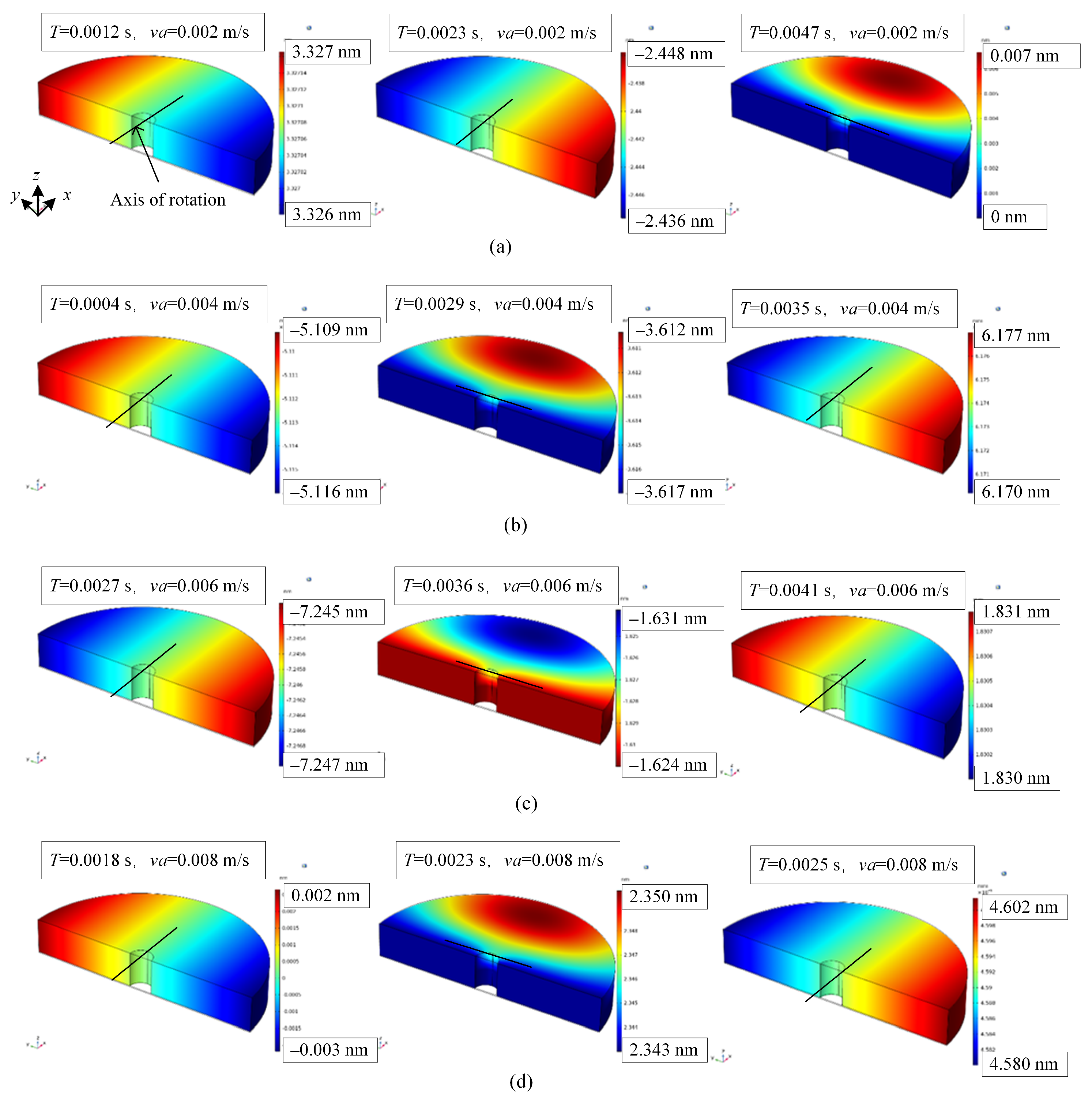
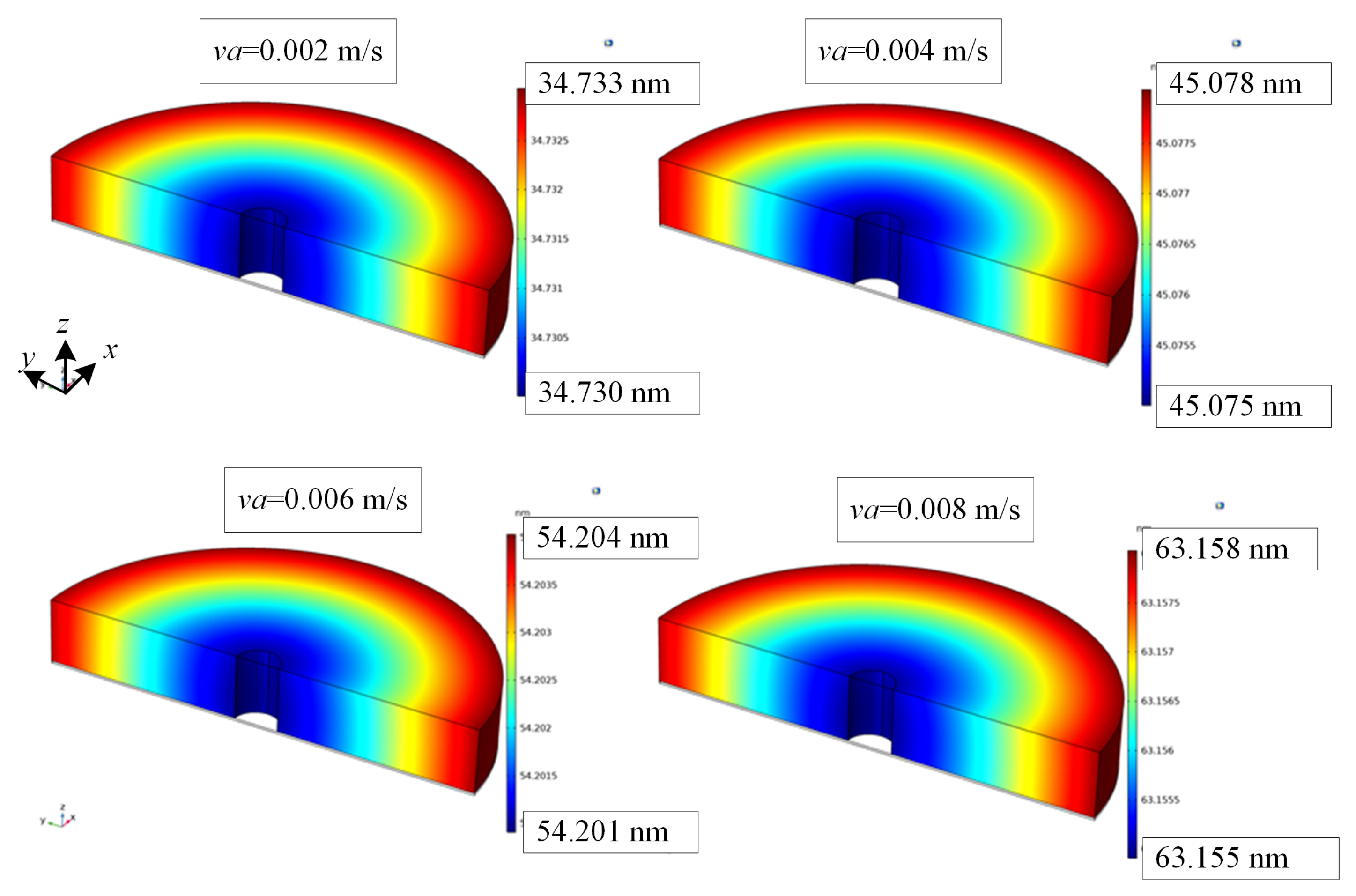
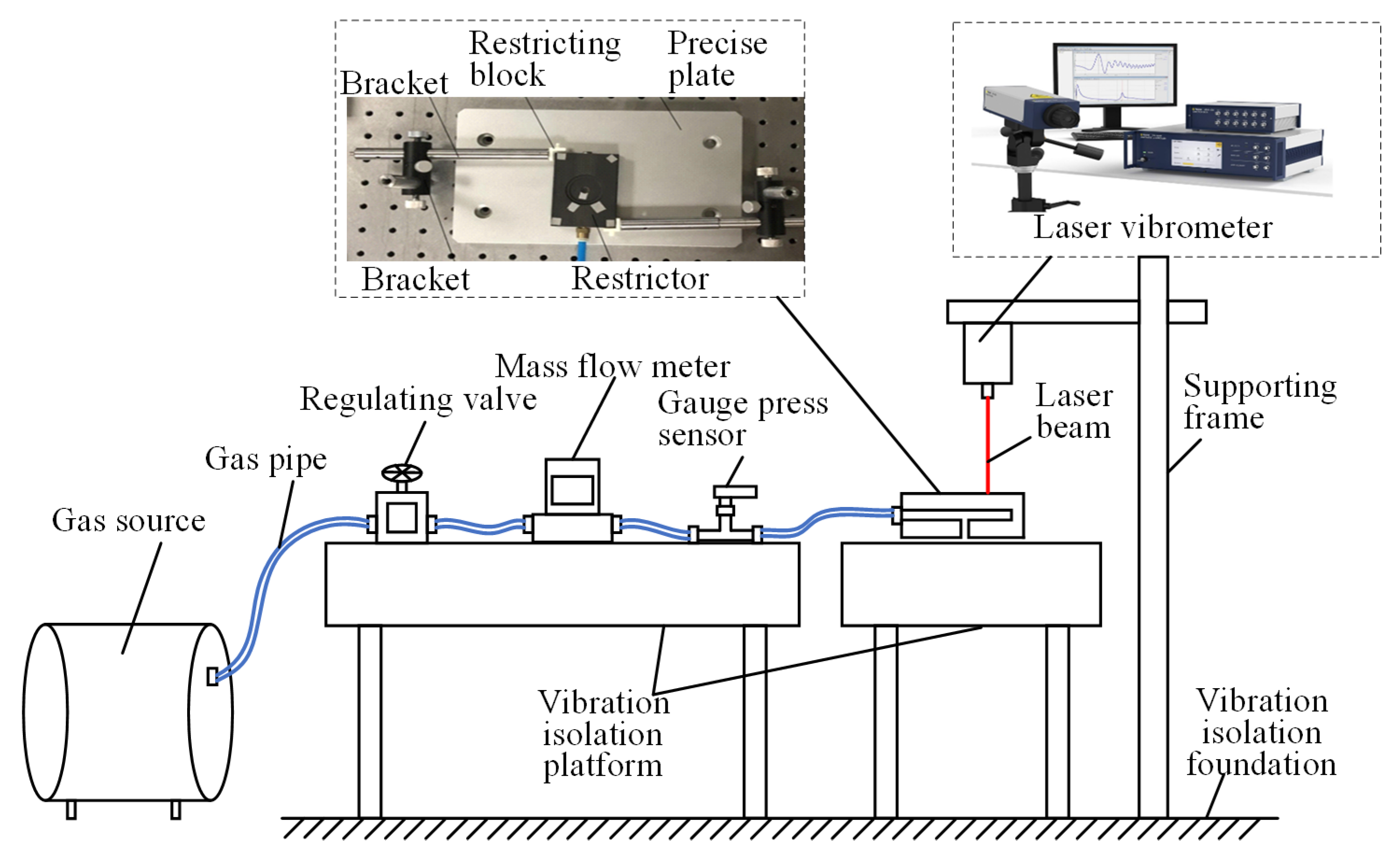

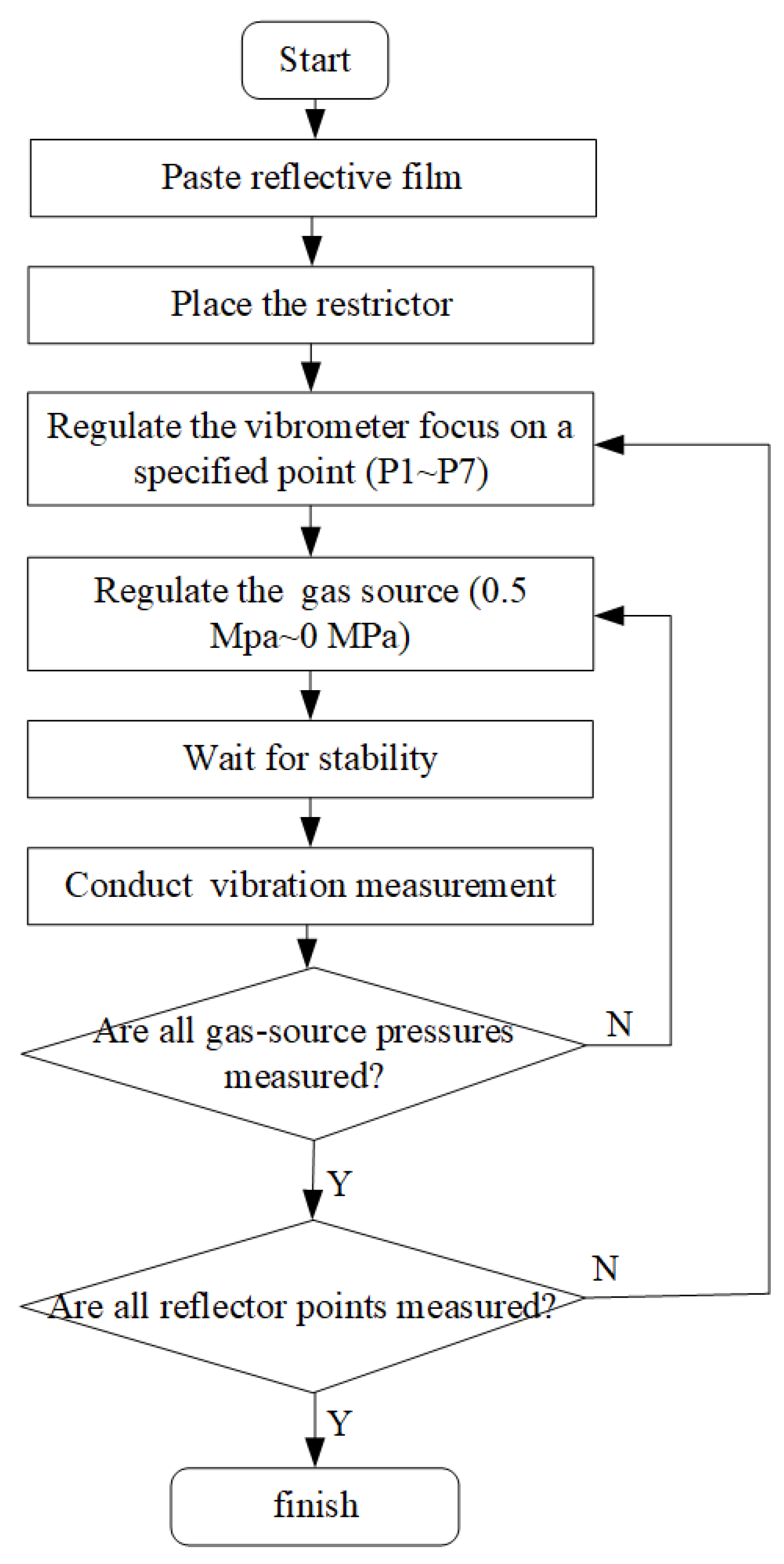
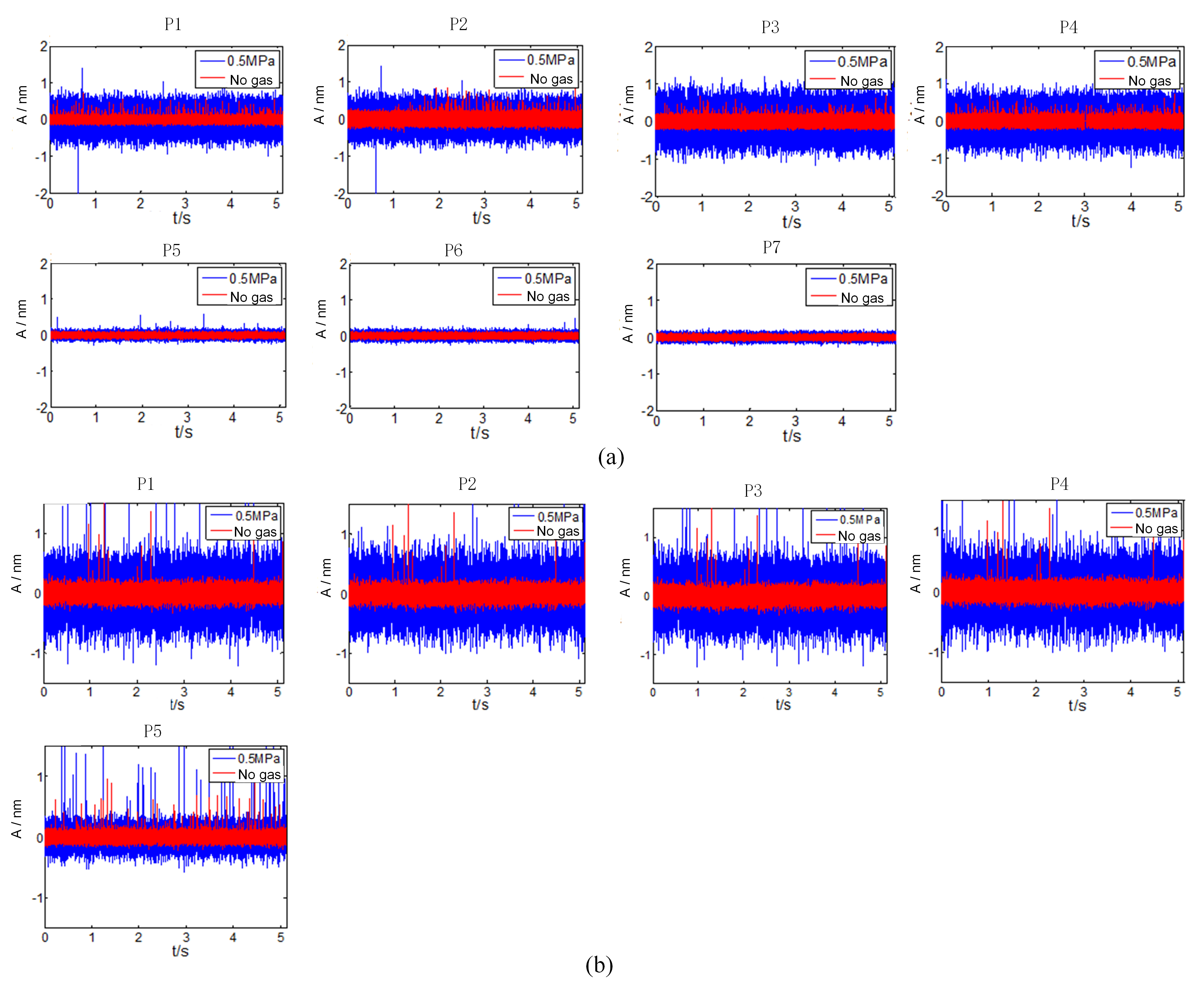

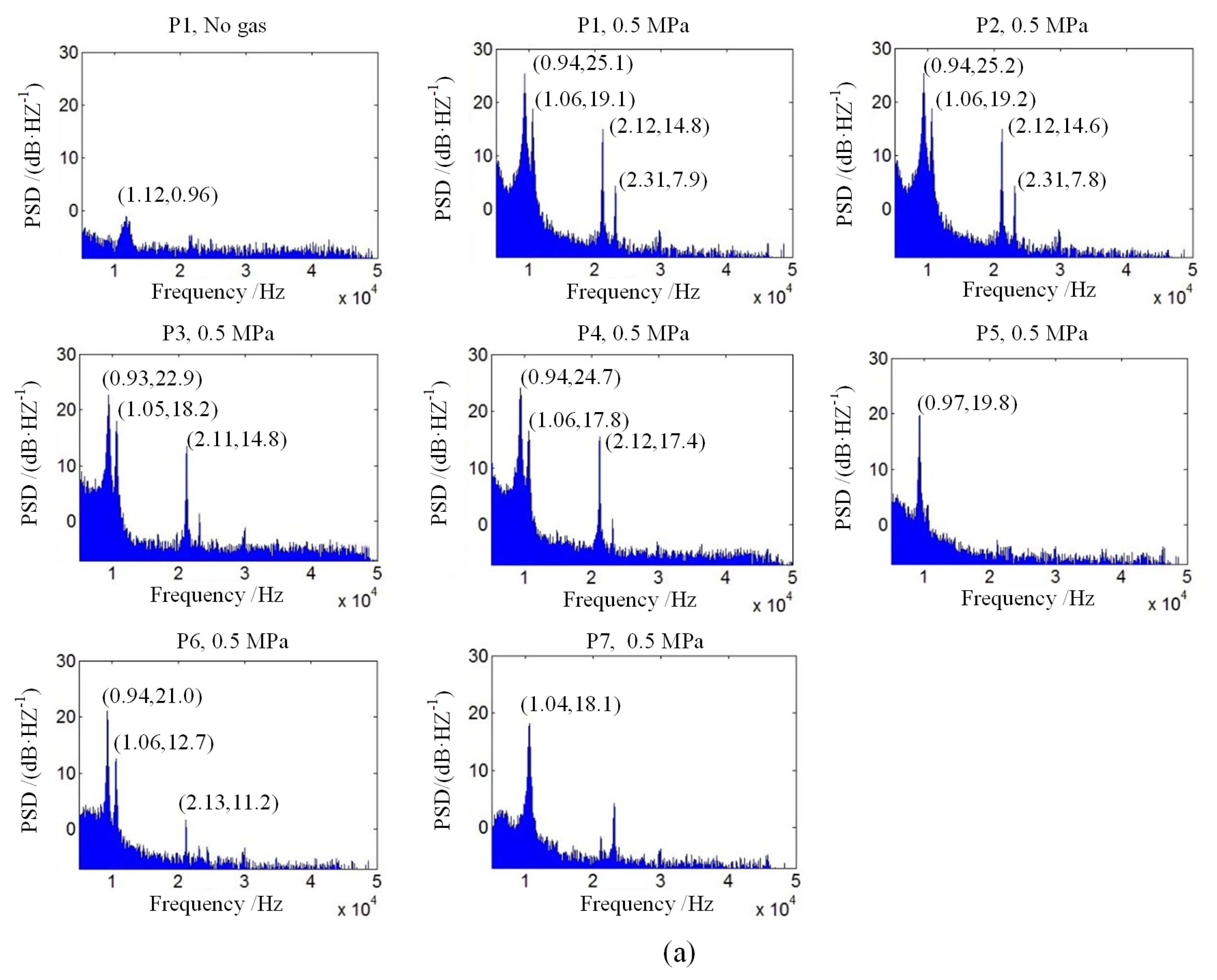
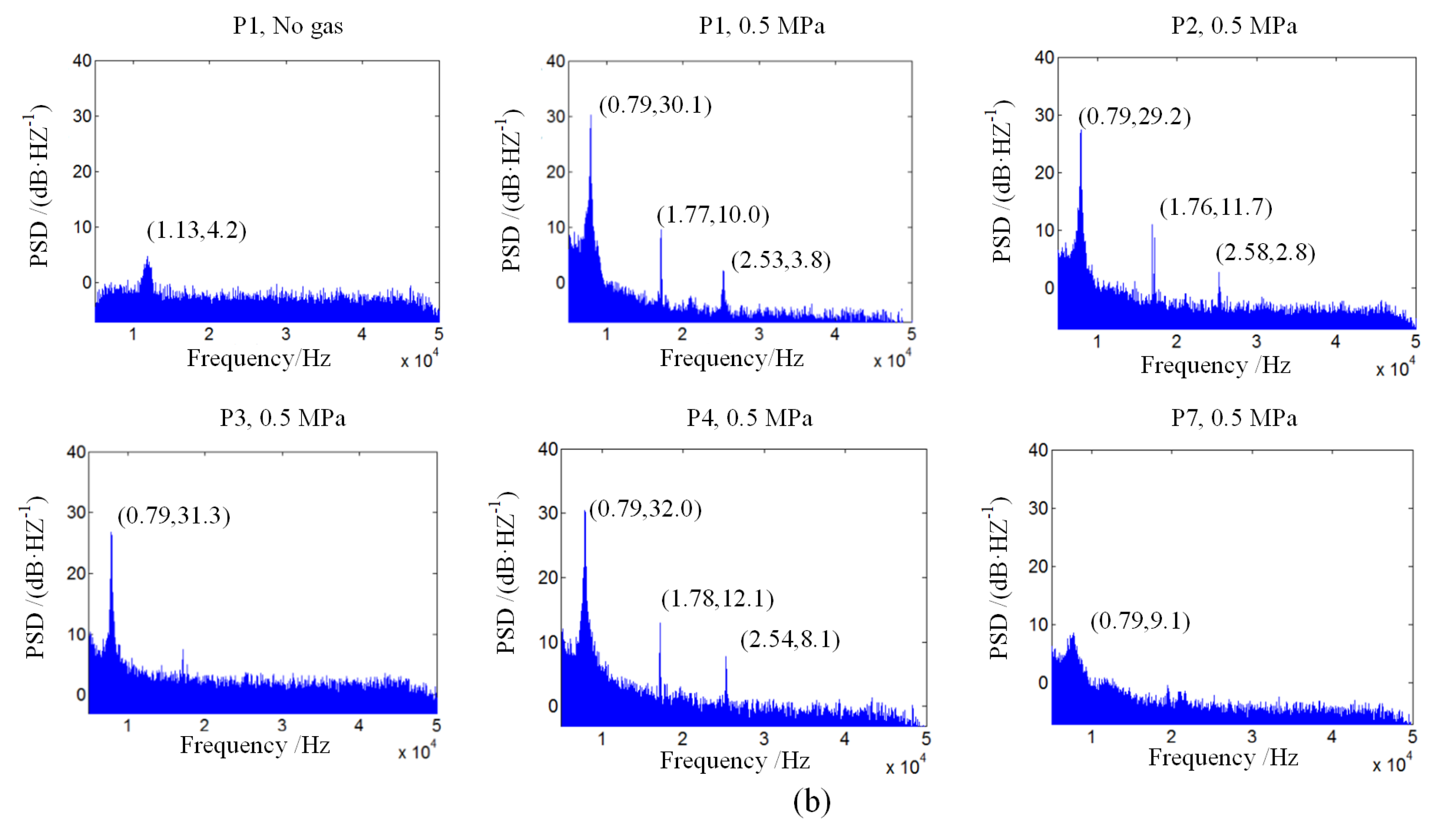
| Gas Source (MPa) | P1 | P2 | P3 | P4 | P5 | P6 | P7 | P1(U) | P2(U) | P3(U) | P4(U) | P7(U) |
|---|---|---|---|---|---|---|---|---|---|---|---|---|
| No gas | 0.21 | 0.29 | 0.26 | 0.28 | 0.18 | 0.17 | 0.18 | 0.39 | 0.35 | 0.32 | 0.45 | 0.33 |
| 0.1 | 0.55 | 0.39 | 0.69 | 0.61 | 0.16 | 0.16 | 0.14 | 1.94 | 2.01 | 2.14 | 2.17 | 0.59 |
| 0.2 | 0.71 | 0.43 | 0.81 | 0.68 | 0.18 | 0.18 | 0.16 | 2.16 | 2.52 | 2.25 | 2.34 | 0.68 |
| 0.3 | 0.97 | 0.57 | 0.87 | 0.70 | 0.21 | 0.20 | 0.19 | 2.87 | 2.96 | 2.72 | 2.99 | 1.93 |
| 0.4 | 1.10 | 0.74 | 0.89 | 0.88 | 0.24 | 0.21 | 0.20 | 3.21 | 3.37 | 3.49 | 3.42 | 2.03 |
| 0.5 | 1.42 | 1.64 | 1.29 | 1.31 | 0.27 | 0.26 | 0.24 | 5.12 | 4.98 | 5.37 | 5.51 | 3.05 |
Publisher’s Note: MDPI stays neutral with regard to jurisdictional claims in published maps and institutional affiliations. |
© 2021 by the authors. Licensee MDPI, Basel, Switzerland. This article is an open access article distributed under the terms and conditions of the Creative Commons Attribution (CC BY) license (https://creativecommons.org/licenses/by/4.0/).
Share and Cite
Shen, X.; Yu, J.; Yin, J.; Li, D. Experimental Study of See-Saw Mode Nano-Vibration on Orifice-Type Restrictors. Appl. Sci. 2021, 11, 5265. https://doi.org/10.3390/app11115265
Shen X, Yu J, Yin J, Li D. Experimental Study of See-Saw Mode Nano-Vibration on Orifice-Type Restrictors. Applied Sciences. 2021; 11(11):5265. https://doi.org/10.3390/app11115265
Chicago/Turabian StyleShen, Xiaoyan, Jing Yu, Jianlong Yin, and Dongsheng Li. 2021. "Experimental Study of See-Saw Mode Nano-Vibration on Orifice-Type Restrictors" Applied Sciences 11, no. 11: 5265. https://doi.org/10.3390/app11115265
APA StyleShen, X., Yu, J., Yin, J., & Li, D. (2021). Experimental Study of See-Saw Mode Nano-Vibration on Orifice-Type Restrictors. Applied Sciences, 11(11), 5265. https://doi.org/10.3390/app11115265





